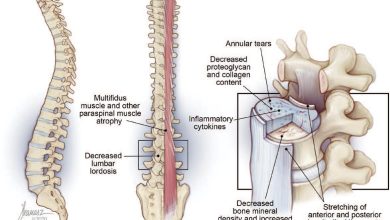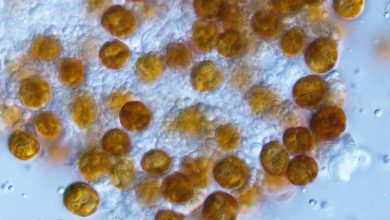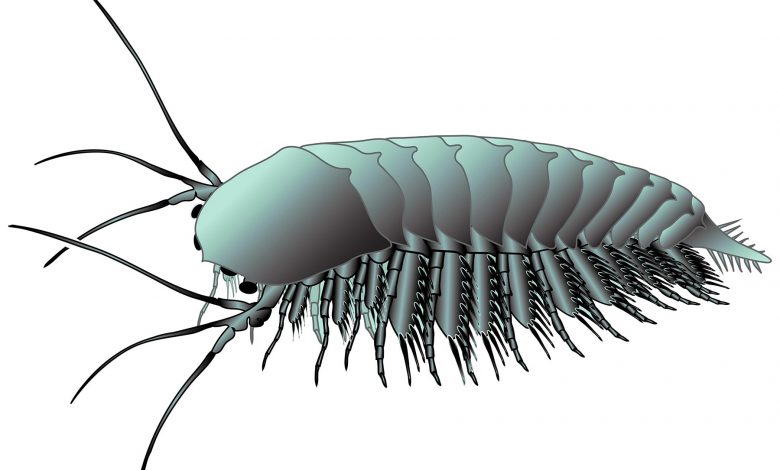
Lead image: An artist’s depiction of a Kaili Leanchoilia showing its long scissor-like appendages situated behind sideward eyes on stubby stalks. Fourteen pairs of appendages likely served a double role – providing the animal with oxygen and allowing it to move about. Credit: Nicholas Strausfeld
Rare fossils preserving the brains of creatures living more than half a billion years ago shed new light on the evolution of arthropods.
Exquisitely preserved fossils left behind by creatures living more than half a billion years ago reveal in great detail identical structures that researchers have long hypothesized must have contributed to the archetypal brain that has been inherited by all arthropods. Arthropods are the most diverse and species-rich taxonomic group of animals and include insects, crustaceans, spiders and scorpions, as well as other, less familiar lineages such as millipedes and centipedes.
The fossils, belonging to an arthropod known as Leanchoilia, confirm the presence – predicted by earlier studies in genetics and developmental biology of insect and spider embryos – of an extreme frontal domain of the brain that is not segmented and is invisible in modern adult arthropods. Despite being invisible, this frontal domain gives rise to several crucial neural centers in the adult arthropod brain, including stem cells that eventually provide centers involved in decision-making and memory. This frontal domain was hypothesized to be distinct from the forebrain, midbrain and hindbrain seen in living arthropods, and it was given the name prosocerebrum, with “proso” meaning “front.”

Described in a paper published on August 19, 2021, in the journal Current Biology, the fossils provide the first evidence of the existence of this discrete prosocerebral brain region, which has a legacy that shows up during the embryonic development of modern arthropods, according to paper lead author Nicholas Strausfeld, a Regents Professor of Neuroscience at the University of Arizona.
“The extraordinary fossils we describe are unlike anything that has been seen before,” Strausfeld said. “Two nervous systems, already unique because they are identically preserved, show that half a billion years ago this most anterior brain region was present and structurally distinct before the evolutionary appearance of the three segmental ganglia that denote the fore-, mid- and hindbrain.”
The term ganglion refers to a system of networks forming a nerve center that occurs in each segment of the nervous system of an arthropod. In living arthropods, the three ganglia that mark the three-part brain condensed together to form a solid mass, obscuring their evolutionary origin as segmented structures.
Fossils of Brain Tissue are Extremely Rare
Discovered in deposits of the Kaili formation – a geological formation in the Guizhou province of southwest China – the fossilized remains of Leanchoilia date back to the Cambrian period, about 508 million years ago. The Kaili fossils occur in sedimentary rock that has high concentrations of iron, the presence of which probably helped preserve soft tissue, which subsequently was replaced by carbon deposits.
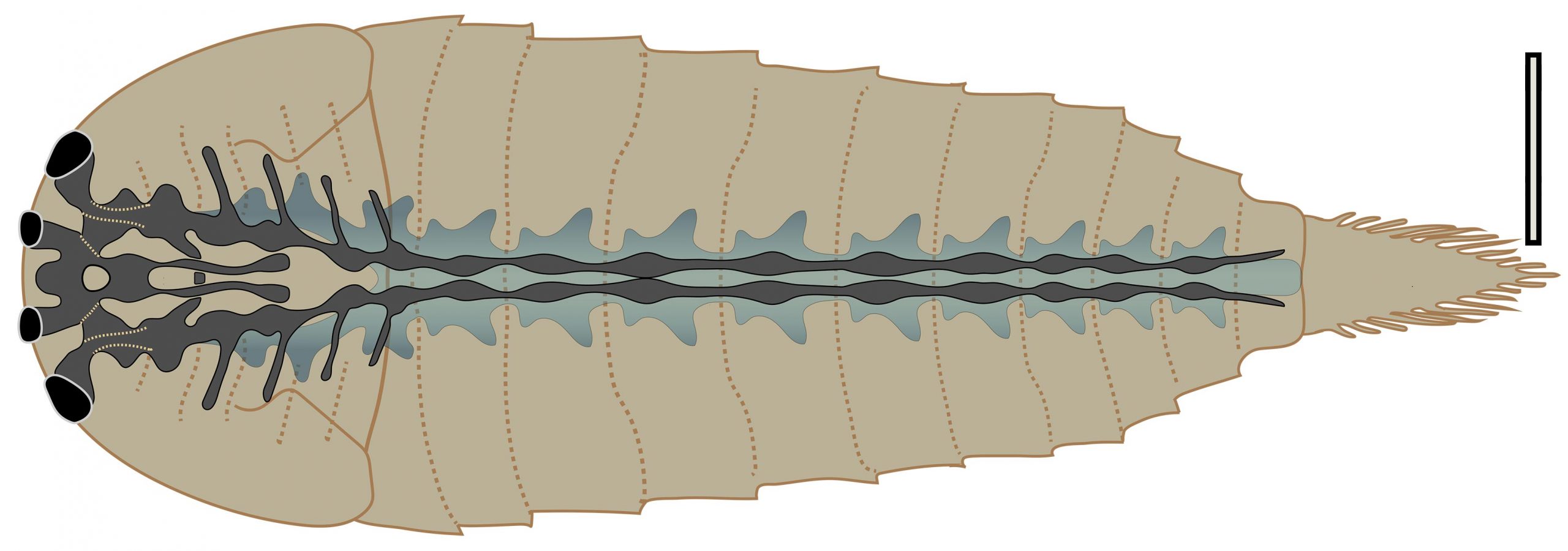
“The Kaili fossils open a window for us to glimpse the body plan evolution of animals that lived more than half a billion years ago,” said the paper’s first author, Tian Lan of the Guizhou Research Center for Palaeobiology at Guizhou University in China. “For the first time, we now know that arthropod fossils of the Kaili formation have the potential to preserve neural tissue that show us the primitive brain of the early stem arthropod existing at the dawn of the animal world.”
“Nervous systems, as other soft tissues, are difficult to fossilize,” added co-author Pedro Martinez of the Universitat de Barcelona and Institut Catalá in Barcelona, Spain. “This makes the study of the early evolution of neural systems a challenging task.”
The fossils also shed new light on the evolutionary origin of two separate visual systems in arthropod evolution: pairs of front-facing eyes or sideward looking eyes, the descendants of which are still present in species living today.
Many arthropods, including insects and crustaceans, have a distinct bilateral pair of faceted compound eyes and another set of less obvious eyes – with more primitive architecture – known as nauplius eyes, or ocelli. These are structurally similar to the principal eyes of spiders and scorpions. These simpler eyes correspond to the prosocerebrum’s forward eyes in Leanchoilia, in line with evidence obtained by previous studies analyzing gene expression patterns during embryonic development of living arthropods.
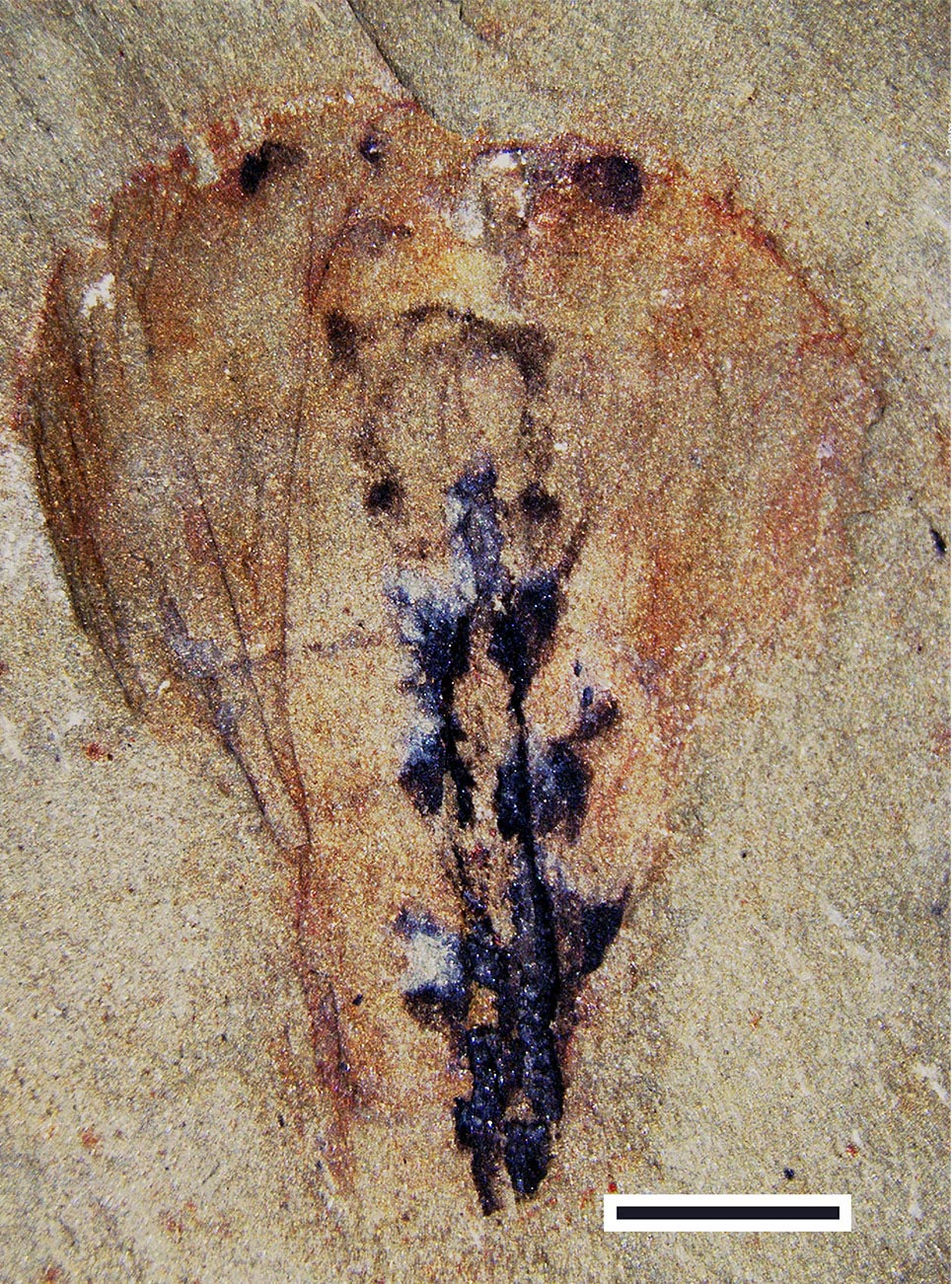
Leanchoilia‘s sideward eyes, on the other hand, relate to the protocerebrum, which is the segmental ganglion defining the arthropod forebrain, lying just behind the prosocerebrum. In living arthropods, the protocerebrum provides the compound eyes of insects and crustaceans, or the lateral single-lens eyes of arachnids, centipedes and millipedes. The visual centers serving those eyes also belong to the brain’s protocerebral region.
Strausfeld explained that in living arthropods, the protocerebrum, or forebrain, has incorporated – in a way, swallowed up – the ancient centers provided by the prosocerebrum, so that it is no longer discernible as a distinct anatomical entity.
The fossils are so well-preserved that they demonstrate that in addition to frontward eyes, the prosocerebrum has also given rise to ganglia associated with the labrum, or “upper lip,” of modern arthropods. The fossils also confirm an earlier hypothesis suggesting that the labrum must have originally evolved from the grasping appendages of Radiodonta, a group of stem-arthropods that were top predators during the Cambrian period.
“When compared with other, similar fossil material belonging to more advanced lineages, the organization of the Leanchoilia brain demonstrates that the ganglionic arrangement of the early brain underwent condensation and fusion of its components, which explains why in living species the prosocerebrum cannot be individually distinguished,” Strausfeld said.
Implications for Brain Evolution in Vertebrates
In addition to closing a century-old gap in the understanding of arthropod brain evolution, the findings have important implications for the early evolution of vertebrate brains, Strausfeld said.
Although simple, fishlike animals existed at the same time as these now-fossilized arthropods, there are no convincing fossils of their brains and, thus, neither fossil evidence nor anatomical evidence for a prosocerebrum in vertebrates. Yet, modern studies show that genes defining the fore- mid- and hindbrains of, for example, mice correspond to genes defining the three ganglionic divisions of the arthropod brain. And in vertebrates, certain crucial centers involved in decision making and in learning and memory have some genetic correspondences with the higher centers in the arthropod brain, which originated in the ancient arthropod prosocerebrum.
Thus, it is plausible that even earlier than the Cambrian period, possibly even before the evolution of segmentally organized body plans, the common ancestor of both vertebrates and invertebrates possessed basic circuits for simple cognition and decision making. And while an ancient prosocerebral-like brain might have been present in the very early ancestors of vertebrates, no such fossil has even suggested evidence for a discrete, nonsegmental domain.
“Nevertheless, one can reasonably speculate that vertebrates have embedded in their ‘modern’ brains parts of an ancient, non-segmented brain that has so far only been demonstrable in an early arthropod, such as Leanchoilia,” Strausfeld said.
Reference: “Leanchoiliidae reveals the ancestral organization of the stem euarthropod brain” by Tian Lan, Yuanlong Zhao, Fangchen Zhao, You He, Pedro Martinez and Nicholas J. Strausfeld, 19 August 2021, Current Biology.
DOI: 10.1016/j.cub.2021.07.048
Additional co-authors on the study are Yuanlong Zhao of the Guizhou Research Center for Palaeobiology at Guizhou University in Guiyang, China; Fangchen Zhao of the State Key Laboratory of Palaeobiology and Stratigraphy of the Chinese Academy of Sciences in Nanjing, China; and You He of Shanghai Synchrotron Radiation Facility.



